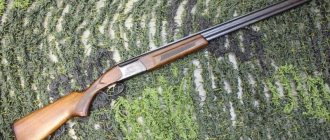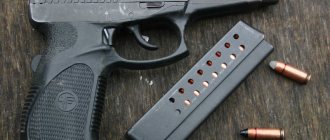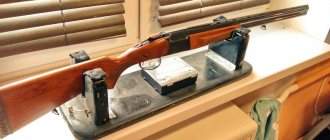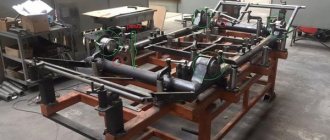Glock 18 pistol
| Early Glock 18 |
In 1987, specifically for the needs of special forces of the army and police, she created the Glock 18 automatic pistol.
Glock 18
Glock 18 is a modification of the Glock 17 pistol and is completely identical to it, with the exception of the possibility of automatic fire.
In addition to the main model, a version of the Glock 18 was offered with a barrel extended to 149 mm, protruding beyond the casing-bolt, with an integrated compensator in the form of a group of holes in the upper muzzle.
A Glock 18C model was also created with the standard dimensions of the basic version, but featuring an integrated barrel lift compensator. The compensator in the Glock 18C model is made in the form of a group of holes in the upper muzzle of the barrel, which corresponds to a cutout in the bolt next to the front sight.
The Glock 18 model pistol aroused the interest of military and police structures, but did not gain popularity due to the low efficiency of automatic fire compared to even compact submachine guns.
| Glock 18 with a barrel extended to 149 mm with an integrated compensator |
| Glock 18 | |
| Caliber, mm | 9×19 Parabellum |
| Length, mm | 186 |
| Barrel length, mm | 114 |
| Height with magazine for 17 rounds, mm | 138 |
| Width, mm | 30 |
| Weight, kg - without magazine - loaded | 0.625 0.905 |
| Magazine weight for 17 rounds, kg - without cartridges - loaded | 0.078 0.280 |
| Store, count. cartridges | 17; 19; 33 |
| Initial bullet speed, m/s | 350 — 360 |
| Sighting range, m | 50 |
| Automatic firing rate, rds/min | 1200 — 1300 |
The automatic operation of the Glock 18 pistol operates according to a short barrel stroke and locking using a protrusion on the barrel that fits into the bolt window for extracting cartridges. The reduction of the trunk is carried out by a figured tide made under the trunk.
The pistol has a striker-fired trigger mechanism, the so-called “Safe Action”, with 3 automatic safeties, including one on the trigger. A feature of the “safe action” trigger is that during the reloading cycle of the pistol, the firing pin is only partially cocked, while it is blocked using an automatic safety lock. The firing pin is re-cocked only when the trigger is pressed, while the firing pin remains blocked from moving forward until the trigger is fully pulled. In this way, it is possible to achieve a uniform force on the trigger from the first to the last shot, which has a positive effect on shooting accuracy. The trigger force is adjusted from 2.5 to 5 kgf by replacing the spring.
| Glock 18C |
The pistol can fire both automatic and single-shot modes.
The continuous rate of fire is 1200-1300 rounds per minute. In addition to the fully automatic type of fire, it is possible to produce a Glock 18 model that fires in bursts of 3 shots (but not within the same model). view of the Glock 18C compensator
The pistol bolt is made of steel using high-precision casting and is subjected to special treatment to increase corrosion and wear resistance.
In the left rear part of the bolt housing there is a fire mode switch lever, which switches shooting from self-loading mode to automatic.
The barrel, as well as the bolt casing, is treated with a special tenifer coating.
The pistol frame is made of impact-resistant, heat-resistant plastic.
Early releases of the pistol had handles with flat cheeks and grooved front and rear surfaces. Pistols of later releases have recesses for fingers on the front side of the grip and small “shelves” for the thumb on their sides. In addition, guides were installed under the barrel for attaching various accessories (laser designator, flashlight, etc.).
Open-type sighting devices are mounted on the flat upper surface of the bolt casing and include a front sight with a sight installed in dovetail grooves. The front sight is equipped with a luminous dot, and the rectangular slot of the sight is framed by a luminous frame.
Glock 18C
The weapon is fed with ammunition from a detachable box magazine with a double-row arrangement of 17 rounds in a checkerboard pattern. Taking into account the possibility of automatic firing, magazines with a capacity of 19 and 33 rounds are also used.
All metal parts of the Glock 18 model pistol are processed using Tennifer technology. As a result of this treatment, the surface to a depth of 0.05 mm acquires a hardness of about 69 Rockwell units (for comparison, the hardness of industrial diamonds is 71-72).
A number of companies have launched the production of additional accessories for pistols of the Glock 18 model, such as a folding stock or a special mount that allows you to use a spare magazine as a front grip for holding.
To ensure that the components of the Glock 18 pistol cannot be used on the frame of the basic Glock 17 pistol (due to the very high unification of pistols in the Glock line), the dimensions of the slide housing guides on the Glock 18 have been slightly changed.
| Glock 18C with folding stock installed and 33-round magazine capacity |
Glock series pistols
| Glock 17 - with under-barrel guides for a flashlight or laser pointer and recesses for fingers on the handle |
The creation of the Glock pistol began in 1980 after the Austrian army announced a competition for the supply of pistols.
And quite suddenly, the competition was won by a little-known company that had previously been engaged in the production of knives and entrenching tools. In 1983, Glock GmbH received an order for 25,000 pistols; this order was simply beyond the capabilities of a small company, so subcontractors had to be involved in production.
Following Austria, this pistol was adopted by the armies of Norway and Sweden. Then these pistols were supplied to the Austrian police, and then to some US police units.
| Glock 18 |
| Glock 19 |
In total, these weapons are now in service with law enforcement units of more than 30 countries (including Belarus). In addition, the Glock 17 went on sale and was very popular as a “civilian” weapon.
| Glock 20 |
| Glock 21 |
The Glock 17 pistol (17 - from a magazine capacity of 17 rounds) was developed by the Austrian company Glock for the Austrian army, and this was the first experience in creating pistols for this company. Nevertheless, the pistol turned out to be extremely successful, reliable and convenient, and was adopted by the Austrian army under the designation P80. In addition, the Glock 17, and then its younger brothers, took a place among the most popular pistols for police and self-defense.
| Glock 22 |
| Glock 23 |
Currently, there are several families of Glock pistols for all major pistol calibers (9 mm pair, .40SV, 10 mm auto, .357SIG, .45ACP, .380/9×17 mm short).
| Glock 24 |
| Glock 25 |
Automation on all Glock pistols works due to the recoil of the barrel with its short stroke. Otherwise, they differ only in caliber, magazine capacity and barrel length (with the exception of the Glock 18, which can fire automatically at a rate of fire of 1100 rounds/min).
| Glock 26 |
| Glock 27 |
The frames of all pistols are made of impact-resistant plastic. The valves are made of steel using high-precision casting and are subjected to special treatment to increase corrosion and wear resistance. The magazines are also made from composite materials.
| Glock 28 |
| Glock 29 |
No sooner had this pistol appeared than the press immediately made a fuss about the fact that the use of plastics supposedly made it impossible for this pistol to be detected by security detectors at airports, etc. But this assertion has no basis - there are enough metal parts in the pistol to trigger the control device.
| Glock 30 |
| Glock 31 |
Early releases of pistols had handles with flat cheeks and grooved front and back surfaces. Pistols of later releases have recesses for fingers on the front side of the grip and small “shelves” for the thumb on their sides. In addition, on the frame of full-size and semi-compact models, now fashionable guides for attaching accessories (laser pointer or flashlight) appeared under the barrel.
| Glock 32 |
| Glock 33 |
For most modifications, options are available with an integrated barrel flip compensator. The compensator is made in the form of a group of holes in the upper muzzle of the barrel, and corresponding cutouts in the bolt next to the front sight. Such models are additionally designated by the index “C” - 17C, 23C, etc.
| Glock 34 |
| Glock 35 |
All families (except .380 caliber) consist of a full-size, compact and sub-compact model and are built according to the short-stroke design and are locked using a lug on the barrel that fits into the bolt window for case extraction. The design used the then widely known principle of a falling barrel to disengage the barrel and bolt, and consisted of only 32 parts. The reduction of the trunk is carried out by a figured tide made under the trunk. Pistols of .380 caliber are built according to the blowback design. All pistols have a striker-fired trigger mechanism of the so-called “Safe Action”, with 3 automatic safeties, including one on the trigger. A feature of the “safe action” firing mechanism is that during the reloading cycle of the pistol, the firing pin is only partially cocked, while it is blocked by an automatic safety. The firing pin is re-cocked only when the trigger is pressed, while the firing pin remains blocked from moving forward until the trigger is fully pulled. Thus, it is possible to achieve a uniform force on the trigger from the first to the last shot, which has a positive effect on shooting accuracy. The trigger force is adjusted from 2.5 to 5 kgf by replacing the spring. The disadvantages of this design sometimes include the inability to re-fire a cartridge that has misfired. Another unpleasant consequence of the design without manual safeties is a fair number of accidents among American police officers, with enviable regularity, shooting themselves in the legs while holstering a pistol.
| Glock 36 |
| Glock 37 |
Glock sights are removable and installed in transverse dovetail grooves. Non-adjustable sights with white or luminous (tritium) dots are installed as standard for easy aiming in low-light conditions. “Sporting” models (for example, Glock 17L) can be equipped with an adjustable rear sight and front sight.
| Glock 38 |
| Glock 39 |
Another highly touted feature of the Glock 17 pistol (and only the 17 model) is the ability to fire underwater. To do this, a special return spring is installed on the gun. In itself, this possibility is not of particular value, since shooting can only be carried out at shallow (on the order of several meters) depths and at ultra-short ranges (a meter or two). On the other hand, such tricks, firstly, demonstrate high structural strength and, secondly, allow you to use the weapon in the presence of water in the barrel (in the rain, for example), which in some other pistols can lead to swelling or even rupture of the barrel.
| Glock 34 with stock, grip, extended magazine |
Especially for the needs of special forces of the army and police, Glock created a version of the Model 17, which has the ability to conduct automatic fire, called the Model 18. The fire mode selector is located on the bolt, the theoretical rate of fire is about 1200 rounds per minute. It is possible to produce variants that fire both in bursts of 3 shots and with fully automatic fire, but not in one model. The Glock 18 can be equipped with increased-capacity magazines (31 rounds). A number of companies produce additional accessories for it, such as a folding stock or a special mount that allows you to use a spare magazine as a front handle for holding. Some parts of the Model 18 (in particular, the bolt) are not interchangeable with similar parts of the Glock 17 pistol for safety reasons.
| Model | Caliber | Length mm. | Barrel length mm. | Width mm. | Height mm. | Weight gr. | Magazine capacity no. cartridges |
| 17 | 9×19 Parabellum | 186 | 114 | 30 | 138 | 625 | 17 |
| 17 C | 9×19 Parabellum | 186 | 114 | 30 | 138 | 620 | 17 |
| 17 L | 9×19 Parabellum | 225 | 153 | 30 | 138 | 670 | 17 |
| 18 | 9×19 Parabellum | 186 | 114 | 30 | 138 | 620 | 17 |
| 19 | 9×19 Parabellum | 174 | 102 | 30 | 127 | 595 | 15 |
| 19 C | 9×19 Parabellum | 174 | 102 | 30 | 127 | 586 | 15 |
| 20 | 10mm Auto | 193 | 117 | 32,5 | 139 | 785 | 15 |
| 20 C | 10mm Auto | 193 | 117 | 32,5 | 139 | 775 | 15 |
| 21 | .45 ACP | 193 | 117 | 32,5 | 139 | 745 | 13 |
| 21 C | .45 ACP | 193 | 117 | 32,5 | 139 | 735 | 13 |
| 22 | .40 S&W | 186 | 114 | 30 | 138 | 650 | 15 |
| 22 C | .40 S&W | 186 | 114 | 30 | 138 | 639 | 15 |
| 23 | .40 S&W | 174 | 102 | 30 | 127 | 600 | 13 |
| 23 C | .40 S&W | 174 | 102 | 30 | 127 | 593 | 13 |
| 24 | .40 S&W | 225 | 153 | 30 | 138 | 757 | 15 |
| 24 C | .40 S&W | 225 | 153 | 30 | 138 | 757 | 15 |
| 25 | .380 Auto | 174 | 102 | 30 | 127 | 570 | 15 |
| 26 | 9×19 Parabellum | 160 | 88 | 30 | 106 | 560 | 10 |
| 27 | .40 S&W | 160 | 88 | 30 | 106 | 560 | 9 |
| 28 | .380 Auto | 160 | 88 | 30 | 106 | 529 | 10 |
| 29 | 10mm Auto | 172 | 96 | 32,5 | 151 | 700 | 10 |
| 30 | .45 ACP | 172 | 96 | 32,5 | 121/113 | 680 | 9/10 |
| 31 | .357 SIG | 186 | 114 | 30 | 138 | 660 | 15 |
| 31 C | .357 SIG | 186 | 114 | 30 | 138 | 660 | 15 |
| 32 | .357 SIG | 174 | 102 | 30 | 127 | 610 | 13 |
| 32 C | .357 SIG | 174 | 102 | 30 | 127 | 610 | 13 |
| 33 | .357 SIG | 160 | 88 | 30 | 106 | 560 | 9 |
| 34 | 9×19 Parabellum | 207 | 135 | 30 | 138 | 650 | 17 |
| 35 | .40 S&W | 207 | 135 | 30 | 138 | 695 | 15 |
| 36 | .45 ACP | 172 | 96 | 28.5 | 121 | 570 | 6 |
| 37 | .45 GAP | 186 | 114 | 30 | 140 | 735 | 10 |
| 38 | .45 GAP | 174 | 102 | 30 | 127 | 685 | 8 |
| 39 | .45 GAP | 160 | 88 | 30 | 127 | 548 | 6 |
Use in popular culture
Glock pistols are a very common feature in movies and computer video games. For example, the favorite weapon of Bruce Willis's character in the movie Die Hard 2 is the same Glock 17.
One of the bandits makes his rounds with a Glock in his hands in the second part of Die Hard.
In addition, pistols from this company are found in such computer games as:
- GTA IV;
- Half Life;
- Counter-Strike and others.
Curious facts
Glock pistols are shrouded in many myths, many of which Glock weapons owe to action movies. Among the main interesting facts are the following:
- contrary to the words of Bruce Willis's character from the movie "Die Hard", the Glock is still detected by metal detectors, since it contains metal parts;
- there is a myth that if a gun is dropped on a hard surface, it can simply burst, like any other plastic product - in fact, this myth has been tested and failed many times;
- The Glock 17 is listed in the Guinness Book of Records as the most reliable pistol.
Design Features of the Glock 17
It is immediately worth highlighting the fact that the design of Glock pistols has always been simple and therefore extremely reliable.
Glock 17
consists of only 33 parts, which makes it very easy to disassemble and just as quickly assemble
The Glock 17 consists of only 33 parts, which makes it very easy to disassemble and also quickly assemble. Complete disassembly and assembly is carried out without special equipment. Among the main features of the Glock 17 pistol are the following:
- One of the main design features of the Glock 17 is that it does not have a traditional trigger that requires a lot of force to fire. There is a “safe trigger” installed here, which is enough for only 2 kg. This allows you to increase the accuracy of fire even in the hands of untrained people.
- The second design feature is the increased survivability of mechanisms and components. By comparison, pistols with the highest reliability are those that are capable of firing about 40 thousand shots without repairs or replacement of parts. The Glock 17 is capable of firing more than 300 thousand shots. The manufacturer says that if handled properly, it can give the owner 500 thousand shots, which is a truly unique parameter.
- The third, but no less important feature is the ability to fire underwater at a depth of no more than 3 meters. This is extremely useful for special forces, for example, Navy SEALs.
History of the creation of weapons
Post-war period (1940-1970) - the Austrian army and police were armed with pistols supplied from the USA - Colt, and the German Walter. Both were outdated and adequate in the 1970s. The small company Glock at that time was engaged in the production of knives, belts and other military accessories made of plastic and metal, and began work on its own pistol.
See also the article Pistols of the “Walter” system and their modifications
1982 - Glock managed to design a very lightweight pistol made of durable plastic. A significant advantage of their model was the “get it - shoot” principle. There is no safety feature, and therefore you can shoot immediately after removing the weapon from the holster, which was ideal for self-defense and police.
The first generation of Glock was adopted by the Austrian army in 1982. The pistol got its name due to the number of rounds in the Glock 17 (in the first model the magazine held 17 pieces).
1980s - Many countries considered the Glock a toy gun due to the fact that it was made of plastic. In fact, a Glock chambered for 9x19 caliber is capable of firing 300 thousand rounds, which is an amazing result.
See also the article Colt pistols and their performance characteristics
Glock is in service in more than 50 countries.
Modernity - the Glock company produces 25 models of its plastic pistol, the most popular among which are the 9 mm Glock-17, Glock-35 and Glock-26. It is also worth mentioning that only Glock 18 and 19 pistols are available with a silencer.
Advantages and disadvantages
Among the advantages of the Glock performance characteristics are the following:
- extremely high corrosion resistance;
- excellent reliability;
- solid shooting accuracy;
- all models can be easily disassembled and assembled without the help of additional equipment;
- the dimensions of the Glock pistol are optimal for the middle palm of a man’s hand;
- a wide variety of shops;
- Thanks to the greater angle of the handle, the pistol fits very comfortably in the hand.
See also the article Saiga 410k and its characteristics
The technical characteristics of the Glock pistol have disadvantages, including:
- the pistol is not designed for high rates of fire - this will cause parts to fail faster;
- To shoot accurately, the pistol must be held tightly in your hands;
- the gun will quickly fail if it fires at temperatures below -40 degrees and +200 Celsius;
- With prolonged use, microcracks appear in the plastic.











